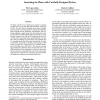Free Online Productivity Tools
i2Speak
i2Symbol
i2OCR
iTex2Img
iWeb2Print
iWeb2Shot
i2Type
iPdf2Split
iPdf2Merge
i2Bopomofo
i2Arabic
i2Style
i2Image
i2PDF
iLatex2Rtf
Sci2ools
173
Voted
AIPS
2011
2011
Searching for Plans with Carefully Designed Probes
We define a probe to be a single action sequence computed greedily from a given state that either terminates in the goal or fails. We show that by designing these probes carefully using a number of existing and new polynomial techniques such as helpful actions, landmarks, commitments, and consistent subgoals, a single probe from the initial state solves by itself 683 out of 980 problems from previous IPCs, a number that compares well with the 627 problems solved by FF in EHC mode, with similar times and plan lengths. We also show that by launching one probe from each expanded state in a standard greedy best first search informed by the additive heuristic, the number of problems solved jumps to 900 (92%), as opposed to FF that solves 827 problems (84%), and LAMA that solves 879 (89%). The success of probes suggests that many domains can be solved easily once a suitable serialization of the landmarks is found, an observation that may open new connections between recent work in plannin...
| Added | 24 Aug 2011 |
| Updated | 24 Aug 2011 |
| Type | Journal |
| Year | 2011 |
| Where | AIPS |
| Authors | Nir Lipovetzky, Hector Geffner |
Comments (0)

